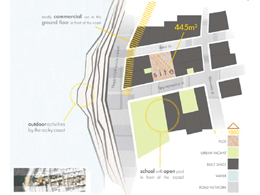STUDENTS PROJECTS
2010

11 December, 2010
Block of flats in Piraeus
The basic goal of this project was the creation of an ecological block of flats and its integration in the urban tissue.
Student: Eleni Katrini
Professor: G. Xaidopoulos
Consultans Professors: E. Evaggelinos
Presentation Date: July 2009
Dissertation Thesis at the National Technical University of Athens School of Architecture
It is a fact that constant building activity has led contemporary cities to a non-viable condition. It is very important for architecture to discover means and ways for the construction being able to upgrade the urban landscape and its microclimate. The typical block of flats had to be revised in order to affect the least possible the environment, and most of all to amend the everyday life of people still living and working in the urban landscape. I chose to deal with residence deliberately, because it is the most common use in the urban context. I wished to do a case-study rather than an individual project which could not be easily applied to the rest of Athens.

The project was worked on three levels: A. Viability, B. Ecology, and C. Construction. Each and everyone of these components included a series of subcomponents. For example, on the level of ecology, it is critical to take into consideration the energy consumption of the building, the bioclimatic design, the ecology of materials, their embodied energies, the ability to reuse parts of the building or recycle the construction materials and so many other parameters. As far as viability of residence is concerned, the quality of the produced space is the most important factor. ~Finally, the construction field includes some individual characteristics, such as economy, ease of constructing and dismantling the building. With this project I aimed to balance somewhere between all these parameters.

The plot is located in Piraeus, in Piraiki neighborhood. It is 445 square meters and has a building factor 3. Around the site there is primarily housing with some commercial use on ground floor.


My analysis of the landmark began with the study of light and shadow, as well as with the shape they create on the plot during the day. I examined the shadows cast by the surrounding buildings throughout the day during the 21st of June (summer solstice) and the 21st of December (winter solstice).

But that was not enough, as a study of the volume of the shadow over the plot was necessary, for I intended to propose a multi-storey building. Thus fragmenting the spatial 3dimensional vacant above the site into a grid on x-y-z axis, I analyzed the amount of shadow that existed in each one of the parts of that grid. The theoretical grid was divided by 5m x 5m x 3m height. So I tracked down all the percentages of light in every part of the grid, from the ground level to a hypothetical 7th floor, creating diagrams. This was a great tool while deciding how much and what form of space each one of the dwellings would occupy.

During the procedure I realized that for all the flats to be well illuminated I had to insert an atrium in the center of the plot, 10 meters wide. In that way the north part of the block is getting satisfactory illumination from the second floor up. The vertical movement is placed in the center next to the atrium, in order to have easy access in every apartment. The vertical movement and the horizontal accesses to the flats are roofed outdoor spaces, so that the light to passes, and that you can view the patio as you move in the building. On the ground floor we have commercial uses due to the direct relationship with the street and the fact that they don't have sufficient light to place a house. Finally, a very important decision was how the residents access the building with a gradual transition from street to the porch and the patio and then on from there through a semi-outdoor movement that leads home. The final apartments were directed to different kinds of people, from families with children, to students, and couples. That's why there are 7 different typologies.

When I was called to select the materials, the decision was difficult. I ended up to a metal construction in order to have ease when constructing and dismantling the building. The main structure of the building is pre-fabricated, and can easily be built on site. Moreover, parts of the building can be reused, and if not metal can be recycled. Regarding the filling of the metal structure, double cement board was selected for the outer skin and double plasterboard for the inner skin of the building, with a 10 cm of Heraklith between them. The top roof of the building is planted, and in that way it is better insulated. Moreover the plants on the roofs and in the atrium create a better microclimate around the building.










